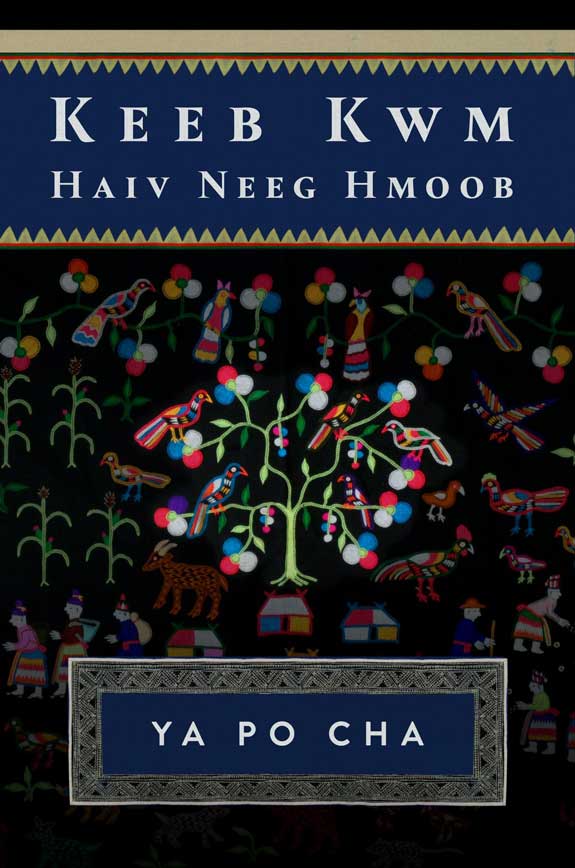Cha is the author of the new book, Keeb Kwm Haiv Neeg Hmoob, published by the Hmong Educational Resources Publisher. As a Hmong world language teacher in the early 2000s, Cha learned that there was no credible literature on Hmong history in the Hmong language. As Cha described it, “I read and started writing bits and pieces of Hmong history in Hmong and used it as reading material in my class. My writing accumulated over time, and I turned it into a manuscript for publishing.” What truly inspired Cha to write this new book is to provide the resources and objective literature on Hmong history for the younger learners. “My motivation came from a genuine interest to provide an objective literature on Hmong history for my students to read and learn,” said Cha.
In the journey of becoming a published Hmong author, Cha has published two books about Hmong people, culture, and history. His first book, An Introduction to Hmong Culture, was published in 2010, and finally, after a decade of putting together a history book, Keeb Kwm Haiv Neeg Hmoob just published in the summer of 2020. As Cha stated, “I did some freelance writing in the early 1990s and learned quickly that being a journalist was not easy, but publishing my writing had been rewarding and I knew someday I was going to pursue it further. After teaching high school for many years, I finally had the time and had gathered enough information, so I decided to publish my first book An Introduction to Hmong Culture in 2010 and then Keeb Kwm Haiv Neeg Hmoob in 2020.”
Throughout history, Hmong people had migrated to many regions and countries. Regardless of where the Hmong are in the world these days, Cha said the Hmong will always be called “Hmong” (or Hmoob), and that is why Cha decided to name his new book Keeb Kwm Haiv Neeg Hmoob. “Hmong people are a uniquely distinct group of people, which in the Hmong language we call ib haiv neeg. The real name of our people is Hmong, although we may have been known and called by many names, our real name is Hmoob and this book is about the history of the Hmong,” said Cha.
It was 16 years ago that Cha started writing Keeb Kwm Haiv Neeg Hmoob. In 2004, Cha started the project as an outline of a presentation about the Hmong history, later turning it into a booklet for Hmong students, and now a published historical book. As Cha commented, “Keeb Kwm Haiv Neeg Hmoob has been written incrementally over a long period of time. It all started in 2004 when it was just an outline on a PowerPoint presentation on the chronology of Hmong history. It was followed by articles and short passages written on various historical accounts of past events, war heroes, etc. These pieces of writings were put together into a booklet in 2012 and used as literature in my Hmong language class. Altogether, it took more than 16 years of incremental writing to put into this book.”
Cha stated that it is important to write and keep records of the Hmong history, especially as so many stories have been lost and there is so much more to learn about the Hmong journey. “Painting vivid pictures in words of our past, that one had ever imagine existed just a couple of decades ago is probably the most satisfying part of writing this book. I learned that we are a proud people with a long history, but there is so much more about our past that we don’t know about,” said Cha.
Keeb Kwm Haiv Neeg Hmoob is about the history of Hmong people going back more than 5,000 years, based on myths and legends before recorded history. It traces the history and migration of our ancestors through time into ancient China where written records were being kept, archeological artifacts substantiate historical accounts, and tales were kept through oral traditions. It continues through the middle ages and into the modern diaspora of the Hmong people. This book details the way life, belief, religion, traditions, cultural practices, war, leadership, adaptations, advancements, and challenges Hmong people have been through the ages. There were triumphant moments in history, as well as tragedies, that illustrate the adversities that Hmong people faced throughout our past and continue to face in the present.
When asked what is Cha’s favorite part of Keeb Kwm Haiv Neeg Hmoob, he indicated, “My favorite part is the battle of Huang Piao, or ntsuj rog Hav Faj Plob. It illustrates strong leadership and a united people that enabled our forefathers to accomplish an extraordinary feat, one that we all can learn from,” said Cha.
Writing can be a lonely journey, but every step of the way, Cha’s family and spouse were his main supporters and motivation in the process. “My family has been very supportive of my writing. My wife, Mai Xee Vue, has been understanding as she has allotted me the time, given me the space, and provided the encouragement that I needed to do my writing. My children are my biggest fans and they are my main motivation. Generations of students have given me positive feedback on my writings,” said Cha.
As a Hmong author, Cha strongly encourages Hmong students and individuals to write and tell their stories. Cha believes that writing down your thoughts, feelings, and ideas help better develop your skills in communicating. “Being a writer has helped me become a better communicator, both verbally and in written form. I have broadened my vocabulary and I have been able to express myself more concisely. More importantly, writing challenges me to do better as time goes by,” said Cha.
Besides working full-time as a teacher in Sacramento, Cha enjoys spending quality time together with family, extended families, and giving back to the Hmong community. “I enjoy being with my extended family from tending to my aging parents to taking road trips with my wife and kids. It is not unusual for me to be helping with weddings (ua mej koob), funerals (ua kav xwm, hais txiv xaiv, ua kis), cultural events, community events, etc.,” said Cha.
As Cha continues to give back to the education and Hmong communities, he hopes to publish more Hmong resources written in the native Hmong language. “There are several writing projects that I have been working on, and they are all in Hmong. I am putting together a Hmong language and grammar book. It should be out in 2021. I have also written extensively on topics such as Hmong weddings and funerals that I might publish in the future,” said Cha.
The Hmong Educational Resources (HER) Publisher believes in the power of education and the impact of stories. HER provides services for Hmong students, writers, educators, researchers, and graphic artists. Cha would like to thank HER Publisher for publishing Keeb Kwm Haiv Neeg Hmoob, and for all the readers and supporters for purchasing his books over the years. “I appreciate the support that everybody has given me. Because your feedback has been positive, constructive feedback goes a long way to help me improve and continue to do better. Ua tsaug for all the support over the years,” said Cha. Fans and readers can follow Ya Po Cha in social media, Facebook page at www.facebook.com/yapocha. To get a copy of this book, please visit HER Publisher at www.herpublisher.com





















